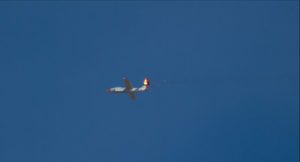
One of the largest defense companies in the world has just tested a game-changing laser that can easily fry rogue drones in midair.
Lockheed Martin released a test video yesterday showcasing its 30-kilowatt class ATHENA (Advanced Test High Energy Asset) system splashing five fixed-wing Outlaw drones at the U.S. Army’s White Sands Missile Range in New Mexico.
In partnership with the Army’s Space and Missile Defense Command, Lockheed Martin funded the anti-drone program to defeat “airborne targets in flight by causing loss of control and structural failure,” according to a corporate statement.
“The tests at White Sands against aerial targets validated our lethality models and replicated the results we’ve seen against static targets at our own test range,” said Keoki Jackson, Lockheed Martin’s Chief Technology Officer. “As we mature the technology behind laser weapon systems, we’re making the entire system more effective and moving closer to a laser weapon that will provide greater protection to our warfighters by taking on more sophisticated threats from a longer range.”
Powered by a Rolls-Royce turbo generator, ATHENA is vaunted as a transportable, ground-based system that serves as a low-cost test bed for demonstrating laser-weapon systems. The company’s laser is called ALADIN (Accelerated Laser Demonstration Initiative) known for “speed, flexibility, precision and low cost per engagement.”
The most recent test will be compared with further demonstrations to dial in the best defensive strategies for defeating hostile, weaponized drones that could threaten military bases, infrastructure facilities or sensitive defense installations during peace and war time.
When it comes to drone technology, Lockheed Martin is wisely playing both sides of the street with new UAV tech and advances in drone mitigation.
Earlier this week, the company announced the release of the OUTRIDER, a canister-launched drone sporting a high degree of wind tolerance and designed to “provide enhanced Situational Awareness (SA) in environments where launching a conventional UAV is not practical.”
In 2015, the company demonstrated an air traffic control system for drones in a fire-fighting scenario. By working in tandem two drones were able to fight a simulate fire while maintaining contact with regular air-traffic systems. One drone located the fire and processed data while the other doused the flames using water or firefighting chemical at precise locations.
Here is a video courtesy of Lockheed Martin.
Jason is a longstanding contributor to DroneLife with an avid interest in all things tech. He focuses on anti-drone technologies and the public safety sector; police, fire, and search and rescue.
Beginning his career as a journalist in 1996, Jason has since written and edited thousands of engaging news articles, blog posts, press releases and online content.
Email Jason
TWITTER:@JasonPReagan
Subscribe to DroneLife here.







[…] company released a test video demonstrating the 30-kilowatt class Advanced Test High Energy Asset system, downing five […]